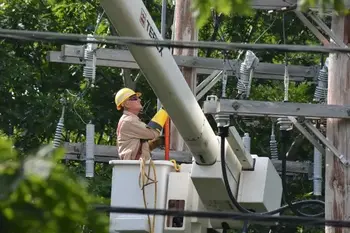Vegetation Management

The Vegetation Management Program
Vegetation management program enhances utility reliability through line clearance, rights-of-way maintenance, hazard mitigation, LiDAR and drone inspections, and predictive analytics to prevent power line contacts, outages, and wildfire risk across distribution and transmission networks.
What Is a Vegetation Management Program?
A utility strategy to control vegetation near power assets, ensuring clearance, safety, compliance, and grid reliability.
✅ Risk-based trimming, pruning, and herbicide for line clearance
✅ LiDAR, drones, and GIS for remote sensing and work planning
✅ NERC/IEEE compliance, outage mitigation, and wildfire prevention
For most North American electric utilities, vegetation management (VM) is a critical part of system maintenance. Utilities strive to maintain normal conditions and ensure the system can withstand normal weather events. Even on a fair day, a broken limb or downed tree can cause an outage. This philosophy mirrors the broader discipline of preventive maintenance, as outlined in resources like what preventive maintenance entails from industry educators, which helps utilities coordinate vegetation work with other routine tasks.
By implementing a successful VM program, utilities can help ensure reliability and mitigate risk. One successful approach to vegetation man agement incorporates four key components that occur simultaneously: cycle pruning, hazard tree mitigation, a midcycle review, and a forestry reliability assessment. This four component program is appropriate for most electric utilities and can be implemented with either internal or external vegetation management resources. Organizations often reinforce these practices through structured crew instruction, with programs such as preventive maintenance training helping align field skills with program objectives.
CYCLE PRUNING
For any utility creating or improving a VM program, cycle pruning should be the primary focus. Cycle pruning is, essentially, preventative maintenance, and technicians and arborists should utilize best management practices and techniques as described in the American National Standards Institute (ANSI) A300: “Standards for Tree Care Maintenance Operations” and its Best Management Practices companion publications. This preventive mindset parallels asset care elsewhere in the utility, where guidance on electric motor maintenance underscores how disciplined routines reduce unexpected failures across the system.
Cycle pruning refers to the period of time in which a utility’s vegetation management team will prune the lines within its territory. For utilities designing a new program, the first step is to determine a cycle length. To do so, a company must balance multiple factors, including clearance created at time of pruning, growth rates of predominant species, climate, risk to system performance, aesthetics, public acceptance of pruning, and cost to implement. Planning also benefits from advances in distribution equipment, as insights from overhead switchgear innovation show how modern devices can support safer, shorter outages during vegetation work.
HAZARD TREE MITIGATION
A hazard tree mitigation program yields the largest annual reliability benefit, as tree and limb failure— through uprooting, falling, breaking, among others— represents a large portion of treerelated interruptions on most electrical systems. By using data analysis tools and a field review, the vegetation management team can identify circuits that have major tree reliability issues related to tree and large limb failure. An entire circuit can then be targeted for systematic risk tree assessment. Depending on desired work management and contracting strategy, targeted circuits may—or may not—correspond to circuits undergoing pruning. A utility can effectively prioritize this hazard tree work by looking at critical portions of targeted circuits. In the Northeast, some utilities have greatly improved treerelated reliability by removing hazard trees along critical portions of a circuit. Utilities increasingly pair field surveys with asset analytics, and condition monitoring in an age of modernization demonstrates how data-driven insights can sharpen risk targeting along critical circuits.
MID-CYCLE REVIEW
A midcycle review is the third component of a comprehensive VM program. Midcycle reviews are conducted between the last circuit pruning and the next forecasted circuit pruning, to review and assess dangers to the electric system. Coordinating these checks with broader facility care, as in electrical substation maintenance, can streamline scheduling across departments.
If a utility is operating on a fiveyear pruning cycle, for example, a mid cycle review should be scheduled for year three or four. This allows the team to identify and address any potential vegetation and electrical contact problems that may arise before the next scheduled pruning. A midcycle review proactively addresses the fastest growing tree species that will grow into the conductors—and potentially cause reliability, restoration, and safety issues—prior to the next cyclic pruning. It may also reduce line inspection time, as inspectors are more readily able to see equipment and its condition. Simple design features such as maintenance inspection windows on transformers also make visual checks faster during patrols and reviews.
FORESTRY RELIABILITY ASSESSMENT
The final component to a comprehensive VM program is a forestry reliability assessment, which involves identifying system reliability concerns that could be addressed via vegetation management work. This piece is often overlooked, but it’s important because it targets portions of circuits for inspection, pruning, and hazardtree removal based on recent historic reliability performance or pressing customer issues.
The goal of this component is to give utilities the flexibility to react to resolve immediate reliability issues not otherwise addressed by the scheduled maintenance programs. The other components in this VM program have schedules that are fixed for an entire year’s worth of work; however, the forestry reliability assessment component allows a VM team to address issues flexibly. The team may handle operations concerns, engineering reliability concerns, or customer concerns in an efficient and effective manner without compromising the integrity of the aforementioned planned components.
Related Articles
Download Our FREE Smart Grid Handbook

Automation of T&D Systems Handbook
This 100+ page handbook is filled with the very latest practical information on SCADA, substation automation, automated mapping/facilities management (AM/FM), and geographic information systems (GIS). This book is ideal for utility T&D automation specialists.
The automation of T&D systems involves the integration of advanced technologies such as real-time monitoring, remote control, fault detection, and predictive analytics to enhance grid performance, reliability, and safety. In this handbook, we explore the fundamental principles behind the automation of power transmission and distribution, along with the latest innovations in Supervisory Control and Data Acquisition (SCADA) systems, Distribution Management Systems (DMS), and advanced metering infrastructure (AMI). We also cover the impact of smart grid technologies, renewable energy integration, and the growing role of digitalization in modernizing electrical networks.
Designed for electrical engineers, system operators, planners, and researchers, this resource provides a thorough understanding of the strategies, tools, and technologies used to automate T&D systems, improve operational efficiency, and ensure grid stability. With a practical approach to real-world applications, the handbook highlights the benefits of automation in reducing operational costs, minimizing downtime, and enhancing fault detection and recovery.
As the global energy landscape evolves, the Automation of T&D Systems Handbook offers crucial insights into how automation is revolutionizing the way we manage and distribute electricity. This guide is an invaluable resource for professionals looking to stay ahead in the rapidly advancing field of smart grid technology and the automation of electrical systems.












